Embouchure is the term for the way the lips and the muscles around the mouth form around the reed. The goal of the embouchure is to support the reed with your lips while allowing maximum vibrations in the reed to create a full, resonant tone. I think of my lips giving the reed the perfect hug, not too weak and not too strong.

Forming the Embouchure
- Open your mouth.
- Form an “O” shape with your lips.
- Place the soaked reed on your bottom lip.
- Close your lips around the reed forming an “O” around the reed.
- Give a gentle hug your lips to apply equal pressure around the reed.
- Hug with the corners of your mouth in addition to your top and bottom lip.
Features of a Good Embouchure
- Equal pressure around the reed (O shape)
- Both lips show a little pink (perfect hug)
- Relaxed lower jaw w space between the teeth (not pushing up on the reed)
- Open oral cavity (hot pizza mouth)
Jaw Alignment:
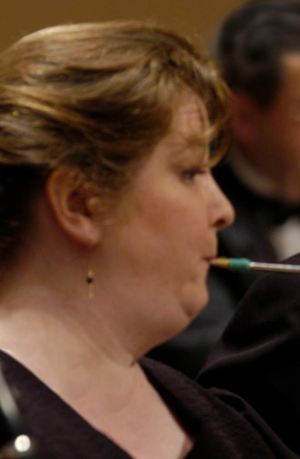
The alignment of the upper and lower jaws should be as close to parallel as your natural jaw alignment allows. The top teeth should close just in front of the center of the bottom teeth. An exaggerated overbite (lower jaw pulled back behind upper jaw) or an underbite (bottom teeth in front of top teeth) will create problems for response, intonation, and tone and will need to be addressed and modified.
Lip Shape & Pressure:
The lips should close around the reed to form an “O” with equal pressure around the reed. This is like the feeling when drinking through a straw, whistling, or blowing bubbles through a bubble wand. The lips function as a gasket around the reed to make sure the air being expelled goes into the reed. Very little pressure is needed in the lower two octaves. Lip pressure will need to increase for notes just above the bass staff and in the third octave. However, too much pressure from the lips will create problems for response, intonation, and tone.
In addition to steady breath support, a good bassoon embouchure will support the reed to produce:
- A full, resonant tone quality,
- Centered/accurate intonation,
- Easy response in all registers,
- A wide dynamic range.
Common Embouchure Issues
“Exaggerated overbite”
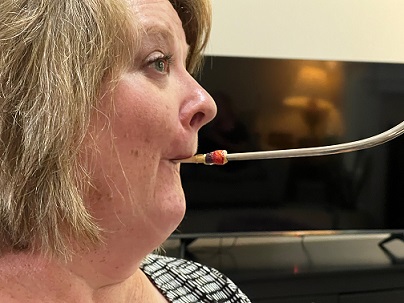
The exaggerated overbite has the lower jaw pulled far back or upper jaw pushed far forward. This creates uneven pressure on the blades of the reed (near the back of the top blade and near the tip on the bottom blade). This closes the reed and creates a sound that is small, and sharp. Low notes are difficult with this jaw alignment.
“Biting” the reed
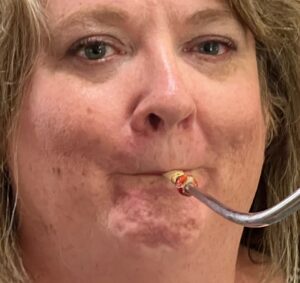
This is what we call “biting the reed”. While the teeth aren’t actually touching the reed, the jaws and lips squeeze so hard that the reed can’t vibrate well. This creates a small, pinched tone that is very sharp. Response on low notes is almost impossible with this tight an embouchure.
- Lips folded in tightly over teeth (no pink showing on bottom lip)
- Excessive pressure from upper and lower jaws
- Closed oral cavity, no space between the teeth
“Smiling Embouchure”

This embouchure is similar to the “biting” embouchure. Flexibility is extremely limited; the tone will be small and muffled; and the pitch will be sharp. Due to a lack of flexibility, the response will be difficult in all registers and the dynamic range will be severely limited.
This problem has the following telltale signs
- corners are pulled up and out
- lips are stretched thinly across the teeth
Helpful Analogies for a Good Embouchure
- Give the reed a perfect hug with your lips.
- “Hot pizza mouth” opens the oral cavity by putting space between the back teeth.
- Milkshake face (form lips like you are drinking a thick milkshake through a straw).
- Whistle gently (not the hailing a cab whistle).
- Say the letter “O” and use that shape for your lips and jaws.
Four Primary Points of Engagement (Pressure)
Visualize an analog clock face. Think of your top lip engaging the reed with pressure directed in toward the center at 10 and 2, and your bottom lip at 8 and 4.
Pressure straight down at 12 and up at 6 will pinch the reed closed and result in a thin, sharp sound and poor response.
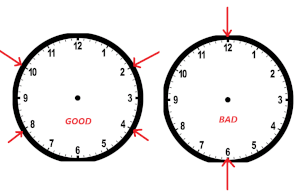
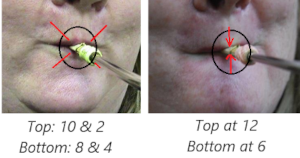

Feedback/Errata